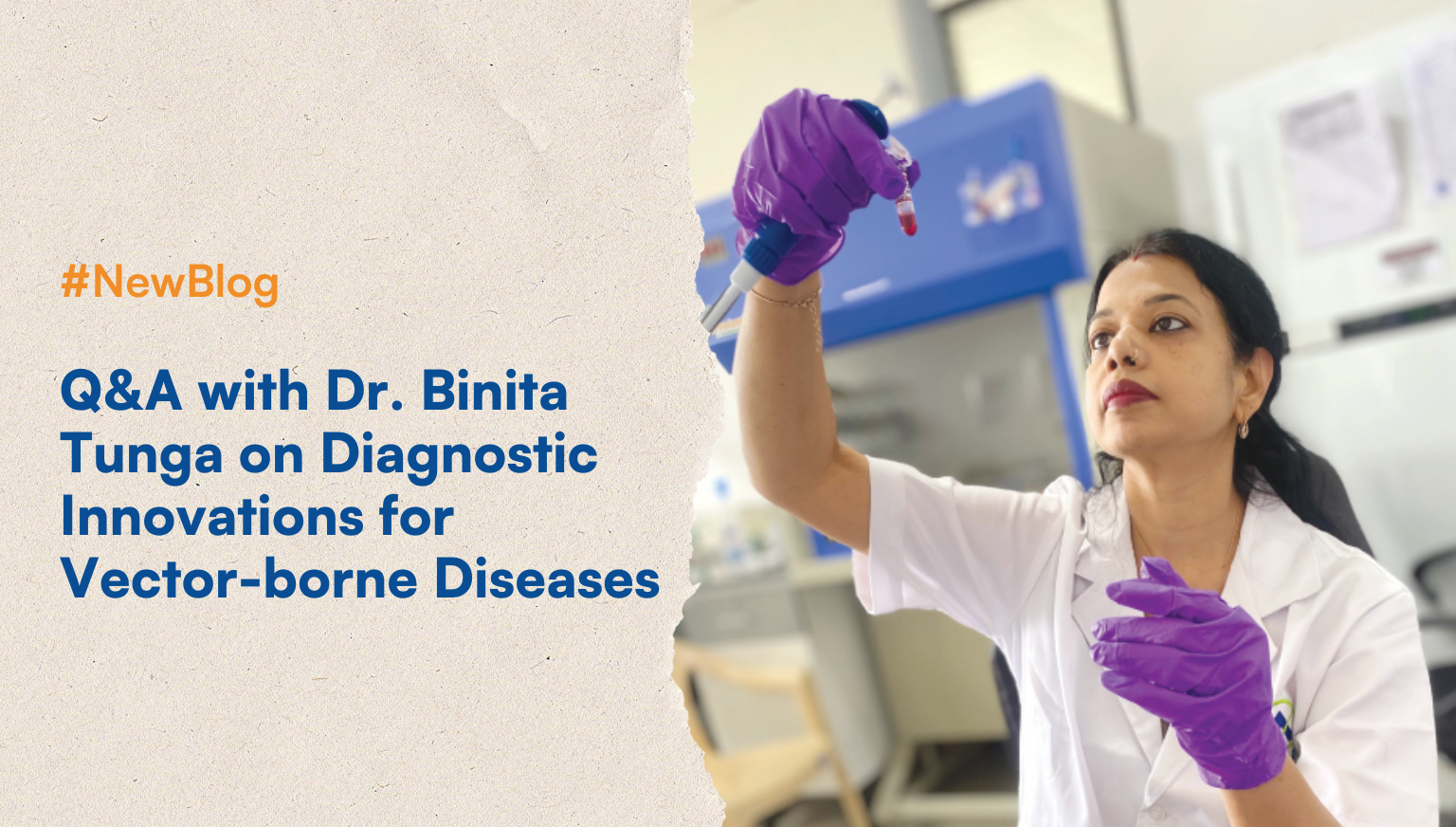
1. Can you tell us about your innovation? What is it designed for?
We developed a single rapid diagnostic device ASSURED, which can simultaneously diagnose early-stage dengue, malaria, and chikungunya based on vertical flow immunoassays with multiplexing capabilities.
Malaria, Dengue, and Chikungunya are three types of mosquito-borne diseases that are quite serious and accompanied by severe symptoms. Because the symptoms are so similar between each of these diseases, it can be quite difficult, if not impossible, to make a conclusive identification of the type of fever without laboratory testing. Although these diseases have almost identical manifestations, it is crucial to differentiate the and detect any co-infection to initiate proper and timely treatment.
2. What prompted you to develop the ASSURED test?
I lost my 11-year-old niece owing to complications arising due to late diagnosis of dengue. She was staying in a big city and got all the care & treatment from a big hospital. Still, we lost her. Postmortem analysis further revealed that she was having co-infection with dengue and malaria, which went undiagnosed. This forced us to see the challenges faced by doctors and medical professionals in rural communities, where they lack this type of combo diagnostic kits as well as lack access to proper and timely treatment.
3. How does the ASSURED technology work?
The test relies on the immobilization of an antibody on a membrane to which the sample of interest (with or without antigen to be detected) is applied. Detection of the bound antigen is subsequently achieved through the binding of an antigen-specific antibody gold conjugate. This step completes a sandwich consisting of a capture antibody, an antigen, and finally the gold conjugate and results in a direct and permanent visually detectable reddish pink-colored dot indicating the presence of the antigen.

Dengue Positive sample

Malaria( falciparum ) & Dengue co-infection sample
4. How far have you reached in terms of its development?
Clinical evaluation has been done as per CDSCO protocol. The device is yet to be launched in the market.
5. Where has the test been piloted so far and what do you envision for the future?
As per the CDSCO protocol, we conducted the clinical evaluation in three CDSCO-approved hospitals i.e. KLES Dr. Prabhakar Kore Hospital & M.R.C, Belagavi, Karnataka; ICMR-RMRIMS, Patna, Bihar; and Government Medical College & Govt. General Hospital (Old RIMSGGH), Srikakulam, Andhra Pradesh where the sample size was 200. Results from hospitals indicated high agreement between the ASSURED Test device and the reference technique across all assessments, with sensitivity, specificity and accuracy consistently reaching > 99%.
Physician feedback regarding the usability of the device was overwhelmingly positive, with respondents expressing confidence in its ease of use and satisfaction with its performance. These findings suggest that the ASSURED Test device holds promise as a reliable and user-friendly tool for rapid diagnosis of malaria, dengue, and chikungunya in remote healthcare settings.
6. How will this innovation bolster the Indian government’s efforts to eliminate vector-borne diseases?
According to the 2021, International Journal of Infectious diseases report, Dengue-Chikungunya coinfection outbreak serological data shows 35.7% Co-infection. ASSURED kit would be a valuable tool in Indian government’s arsenal for combating and eliminating vector-borne diseases. By improving diagnosis, surveillance, and control efforts, such a kit can help accelerate progress towards the goal of eliminating vector-borne diseases and improving public health outcomes in India.
7. How is Ameliorate’s fever panel fit for the last mile, to reach the underserved?
ASSURED uses whole blood as a sample rather than serum, eliminating the extra steps for sample preparation. The test uses vertical flow technology, resulting in larger sample volume capacity and significantly higher multiplexing capabilities. Furthermore, it is able to detect co-infections and saves time for treatment for both doctors and patients. Finally, ASSURED does not need any instrument for testing, nor is cold chain required for its transport.
8. What do you think are the bottlenecks currently to put the final nail in the malaria coffin?
Among the main obstacles impeding efforts to eradicate malaria are the emergence of drug-resistant parasite variants, limited access to effective treatments and diagnostics, insecticide resistance in mosquitoes, the potential impact of climate change on mosquito breeding habits, and the alteration of geographic range of malaria transmission. To create new instruments, technologies, and tactics for the prevention and treatment of malaria, there must be continuous investment in research and innovation. Continuous research, innovation, and multi-sectoral strategies are needed to overcome these obstacles, along with consistent dedication and cooperation at international, national, and local levels.
9. How is funding from IHF making a difference for your innovation?
The 12-month funding from IHF will enable prospective, multicentric performance and cost-effectiveness evaluation of the RDT, to be made available at a discounted price of Rs 200/pc to the public health system for government procurements. This is far less than the existing fever panels priced at Rs 3000-4000.
10. Any first results from the deployments that you can share?
Results from hospitals indicated high agreement between the ASSURED Test device and the reference technique across all assessments, with sensitivity, specificity, and accuracy consistently reaching >99%. Physician feedback regarding the usability of the device was overwhelmingly positive, with respondents expressing confidence in its ease of use and satisfaction with its performance. These findings suggest that the ASSURED Test device holds promise as a reliable and user-friendly tool for rapid diagnosis of febrile illnesses in clinical settings.
11. Any personal quotes from patients/healthcare workers on how Ameliorate is making a difference in their lives?
As stated by Dr. Nanda Kishore Alva, Professor of Pathology, Ramaiah Medical College, “All three of these vector borne diseases come with similar signs and symptoms, so making an early diagnosis is what matters the most. This single rapid diagnostic device is a wonderful idea as it allows us to assess for all three diseases and tell the patient yes, you have chickungunya, or yes, you have malaria, which can either be vivax or falciparum, or your are suffering from dengue.”
Source:
https://youtu.be/2j6lgyeuAic?list=PLzLOoXj3TJIONo1xLkUWKx0NhgrWdau0d
12. Climate change is dramatically altering the geography, frequency and burden of vector-borne diseases like malaria. What is your outlook for the future, especially on how diagnostics can help tackle this Climate X Health challenge?
Climate change is causing changes in vector-borne diseases, affecting their distribution, seasonality, and intensity. Rapid diagnostic tests (RDTs) enable early detection and response, allowing health authorities to respond quickly to emerging hotspots. They are essential for surveillance and monitoring of disease transmission, identifying vulnerable populations and guiding interventions. Continued investment in diagnostic technologies and integration with climate data is crucial for addressing these challenges. By leveraging advanced technologies and integrating diagnostic data with climate information, we can enhance our ability to detect, monitor, and respond to changes in vector borne disease transmission, contributing to more effective control and elimination efforts.
About the Author:

Dr. Binita Tunga holds a Ph.D. in Molecular Biology from the Indian Institute of Technology, Kharagpur, and a Post-Doctoral Fellowship from Osaka University, Japan. With 15 years of industrial experience, including as Senior Scientist and Head of Analytical and Quality Control Departments at prominent biopharmaceutical companies, she went on to create Ameliorate Biotech Pvt. Ltd. with the aim of developing innovative solutions that can revolutionize healthcare and address healthcare disparities, particularly in remote areas of India.
